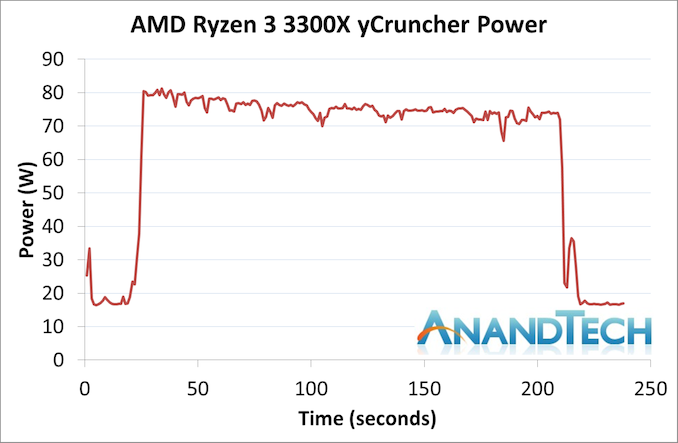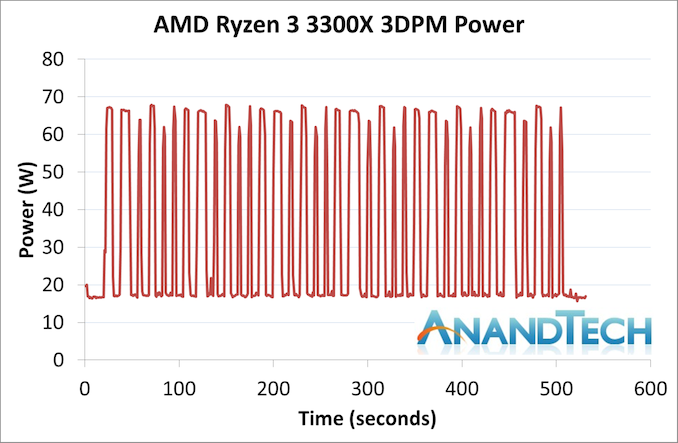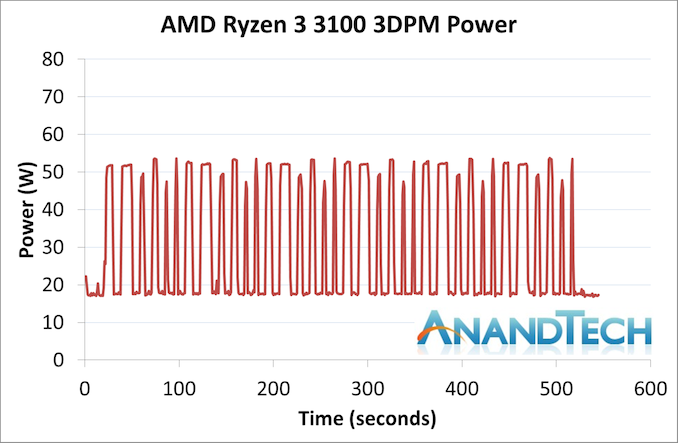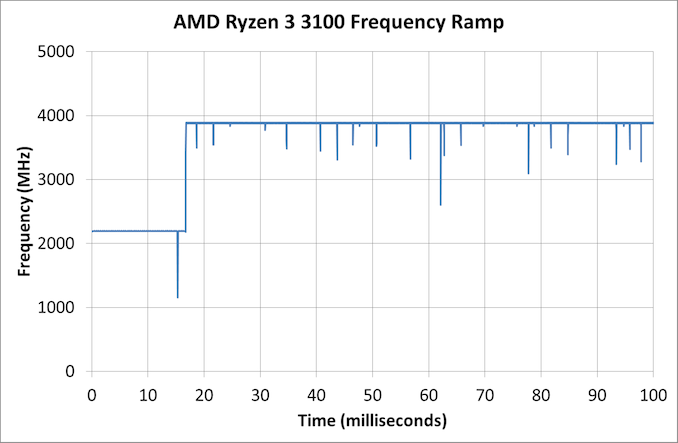The AMD Ryzen 3 3300X and 3100 CPU Review: A Budget Gaming Bonanza
by Dr. Ian Cutress on May 7, 2020 9:00 AM ESTPower Consumption and Frequency Ramps
On the box, both processors are listed as having 65 W TDPs. With its Zen-based hardware, AMD has been relatively good at staying around that official on-the-box value, even during turbo. In the last generation, AMD introduced a feature called PPT, or Package Power Tracking.
- For 105 W processors, PPT is >142 W
- For 65 W processors, PPT is >88 W
- For 45 W processors, PPT is >60W
This allows the processor to raise its power limits, assuming it isn’t breaching thermal limits or current limits, and consequently raise the frequency. As a result, while we see 65 W on the box, the real world power consumption during most tasks is likely to be nearer 88 W, unless the current or thermal lines are crossed.
As a new element to our testing, we are recording power over a number of benchmarks in our suite, rather than just a simple peak power test.
AMD Ryzen 3 3300X
For the faster chip, we saw a peak power in both of our tests of around 80 W.
With yCruncher, which is somewhat of a periodic load, the power consumption dropped over time to nearer 75 W.
3DPM is more obvious with its idle steps between loads, being 10 seconds on then 10 seconds waiting. The power almost peaked at a similar amount here.
In both of these graphs, the package power when idle is around 16-17 W. I looked back through the data, and noticed that out of this power only 0.3 W was actually dedicated to cores, with the rest being towards the big IO die, the memory controllers, and the Infinity Fabric. That’s still pretty substantial for an idle load.
At low loads, the power per core was around 14 W, while at full load it was slightly less depending on the test. This is a bit away from the 20 W per core we get from the high end Zen 2 processors, but these only go to 4.3 GHz, not 4.7 GHz+. This is about in line with what we expect.
On our frequency ramp test, the Ryzen 3300X went from an idle state to peak power within 17 milliseconds, or approximately a frame at 60 Hz.
One of the new features with Ryzen 3000 is CPPC2 support, which AMD claims to reduce idle-to-turbo ramping from 30 milliseconds to 2 milliseconds. We’re seeing something in the middle of that, despite having all the updates applied. That being said, the jump up to the peak frequency (we measured 4350 MHz, +50 MHz over the turbo on the box) is effectively immediate with zero skew across a range of frequencies.
AMD Ryzen 3 3100
Given that the TDP number on the side of the box says 65 W as well, any reasonable user would assume that the power of this chip would be equal, right? Regular readers will know that this isn’t always the case.
In our yCruncher test, because the turbo frequency is lower than the 3300X, it means the voltage can be lower, and thus power is lower. Our history of testing Zen 2 has shown that these cores get very efficient at lower frequencies, to the point where our processor doesn’t even break that 65 W threshold during yCruncher.
Similarly the 3DPM peaks are also lower, barely going to 55 W during an AVX2 workload.
On the frequency ramp side, we see another instance of a 16-17 ms transition.
Summary
For the peak power out of all of our testing, we saw the Ryzen 3 3300X hit a maximum of 80 W, and the Ryzen 3 3100 go to 62 W. When we compare that to the Core i7-7700K, at 91 W TDP / 95 W peak, combined with most of the results on the next few pages, AMD by comparison is more efficient.
















249 Comments
View All Comments
destorofall - Thursday, May 7, 2020 - link
you sound butthurt0ldman79 - Thursday, May 7, 2020 - link
Heaven forbid his data set of God knows how many CPU doesn't include the one you want to see...Damn, you really should demand a refund.
LMonty - Thursday, May 7, 2020 - link
You should really file a complaint, buddy. Gotta fight for your rights. ;Pjimbo2779 - Sunday, May 10, 2020 - link
What has happened to the comments section here. Can we go back to just ignoring the ignoramus'. It often means they just go away.psychobriggsy - Thursday, May 7, 2020 - link
It was mentioned that Intel didn't even send these CPUs out for review, and that they're hard to obtain because Intel isn't making many of them.However, a few more data points would be nice. I think Ian needs to set up a system test datacentre like Phoronix so the rebuilding is kept to a minimum!
twizzlebizzle22 - Thursday, May 7, 2020 - link
AMD must have sent the 7700k or specified it's use. I've noticed every review using that specific CPU. AMD aiming for the used market upgraders it seems.amrnuke - Thursday, May 7, 2020 - link
I believe that's the last Intel chip that was 4C/8T as well, right? Seems a fair comparison, I guess if AMD really think that's the market.Anyway, TechPowerUp went ahead and lined up the 3300X against a bunch of other relevant chips (https://www.techpowerup.com/review/amd-ryzen-3-330... It's 1% slower than the 3600 at 720P gaming, 16.5% slower than the 9900K at 720P gaming.
CPU tests show the 4C/8T 3300X holding up well to the 6C/6T 8600K and 9400F. It pretty well trounces the 9100F.
The 3100 beats the 9100F by 14% in CPU tests.
schujj07 - Thursday, May 7, 2020 - link
720p gaming isn't even relevant. If these were iGPU tests then sure, but even a GTX 1050 can do better than 720p gaming.supdawgwtfd - Thursday, May 7, 2020 - link
Are you stupid?To test CPU performance you run lower resolution to ensure the CPU is the bottleneck
Your comment is not relevant.
schujj07 - Saturday, May 9, 2020 - link
Hence why most review sites use 1080p. 720p benchmarking on modern hardware is akin to Quake 3 benchmarking at 640x480 resolution back in 2000. All you end up seeing are crazy high numbers that don't mean anything. We see it all the time that CPU A is faster at 720p but then slower at 1080p?